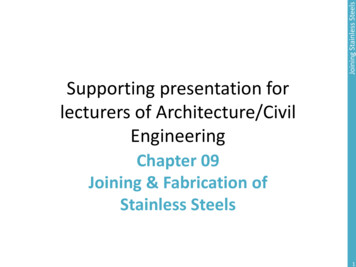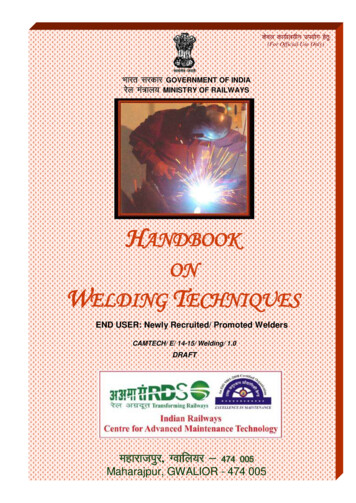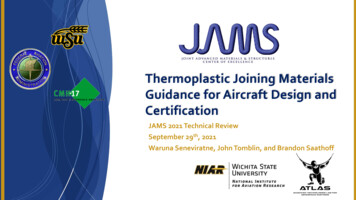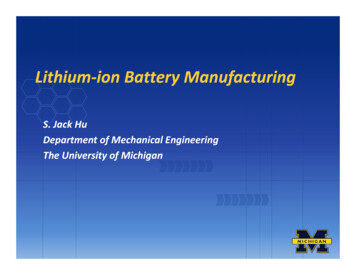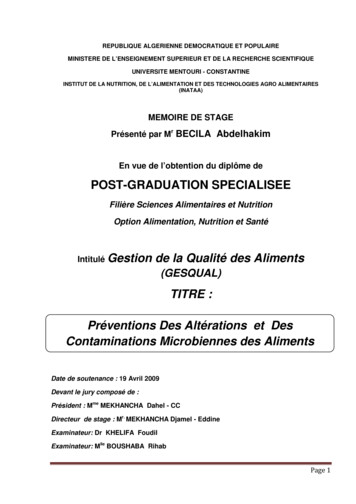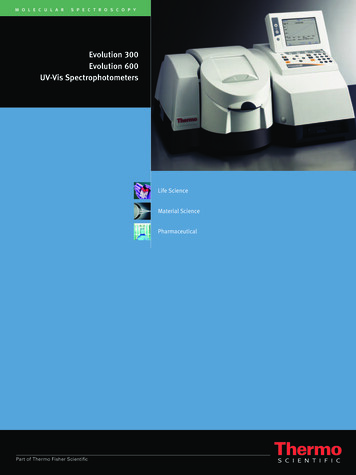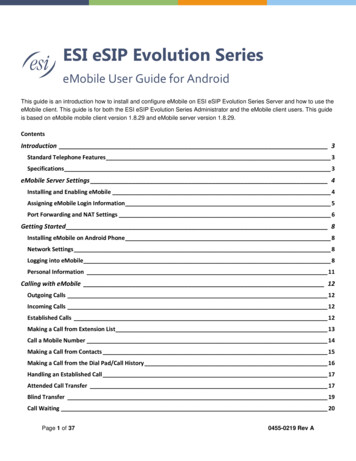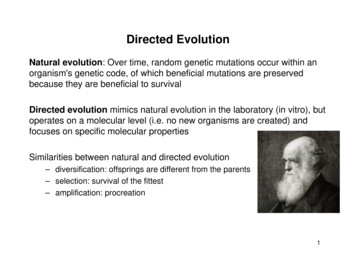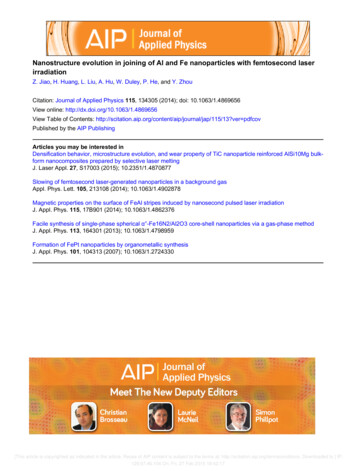
Transcription
Nanostructure evolution in joining of Al and Fe nanoparticles with femtosecond laserirradiationZ. Jiao, H. Huang, L. Liu, A. Hu, W. Duley, P. He, and Y. ZhouCitation: Journal of Applied Physics 115, 134305 (2014); doi: 10.1063/1.4869656View online: http://dx.doi.org/10.1063/1.4869656View Table of Contents: 15/13?ver pdfcovPublished by the AIP PublishingArticles you may be interested inDensification behavior, microstructure evolution, and wear property of TiC nanoparticle reinforced AlSi10Mg bulkform nanocomposites prepared by selective laser meltingJ. Laser Appl. 27, S17003 (2015); 10.2351/1.4870877Slowing of femtosecond laser-generated nanoparticles in a background gasAppl. Phys. Lett. 105, 213108 (2014); 10.1063/1.4902878Magnetic properties on the surface of FeAl stripes induced by nanosecond pulsed laser irradiationJ. Appl. Phys. 115, 17B901 (2014); 10.1063/1.4862376Facile synthesis of single-phase spherical α″-Fe16N2/Al2O3 core-shell nanoparticles via a gas-phase methodJ. Appl. Phys. 113, 164301 (2013); 10.1063/1.4798959Formation of FePt nanoparticles by organometallic synthesisJ. Appl. Phys. 101, 104313 (2007); 10.1063/1.2724330[This article is copyrighted as indicated in the article. Reuse of AIP content is subject to the terms at: http://scitation.aip.org/termsconditions. Downloaded to ] IP:129.97.46.104 On: Fri, 27 Feb 2015 19:42:17
JOURNAL OF APPLIED PHYSICS 115, 134305 (2014)Nanostructure evolution in joining of Al and Fe nanoparticles withfemtosecond laser irradiationZ. Jiao,1,2 H. Huang,2,3 L. Liu,3,4 A. Hu,3,5 W. Duley,2,6 P. He,1,a) and Y. Zhou2,3,a)1State Key Laboratory of Advanced Welding Production Technology, Harbin Institute of Technology,Harbin 150001, China2Centre for Advanced Materials Joining, University of Waterloo, Waterloo, Ontario N2L 3G1, Canada3Department of Mechanical and Mechatronics Engineering, University of Waterloo, Waterloo,Ontario N2L 3G1, Canada4Department of Mechanical Engineering, Tsinghua University, Beijing 100084, China5Department of Mechanical, Aerospace, and Biomedical Engineering, University of Tennessee,Knoxville, Tennessee 37916, USA6Department of Physics and Astronomy, University of Waterloo, Waterloo, Ontario N2L 3G1, Canada(Received 12 February 2014; accepted 14 March 2014; published online 1 April 2014)The joining of Al-Fe nanoparticles (NPs) by femtosecond (fs) laser irradiation is reported in thispaper. Fe and Al NPs were deposited on a carbon film in vacuum via fs laser ablation. Particleswere then exposed to multiple fs laser pulses at fluences between 0.5 and 1.3 mJ/cm2. TransmissionElectron Microscopy (TEM) and Electron Diffraction X-ray observations indicate that Al and FeNPs bond to each other under these conditions. For comparison, bonding of Al to Al and Fe to FeNPs was also investigated. The nanostructure, as observed using TEM, showed that individual AlNPs were monocrystalline while individual Fe NPs were polycrystalline prior to joining and thatthese structures are retained after the formation of Al-Al and Fe-Fe NPs. Al-Fe NPs produced by fslaser joining exhibited a mixed amorphous and crystalline phase at the interface. Bonding issuggested to originate from intermixing within a region of high field intensity between particles.C 2014 AIP Publishing LLC. [http://dx.doi.org/10.1063/1.4869656]VI. INTRODUCTIONRecently, rapid progress in nanoscience and nanotechnology has generated a high demand for techniques that canbe used for the joining of nanoscale building blocks to facilitate the assembly of systems having complex functionality.1,2 The joining of nanoparticles (NPs) is basic to thisdeveloping technology and is fundamental in the integrationof nanoscale products. An important aspect of joining at thenano-scale is the maintenance of control over the meltingdepth in NPs.3 When two NPs are completely melted, thesurface tension causes the two NPs to merge to form a largerparticle.4 Irradiation with fs laser pulses minimizes bulkheating effects and offers new promise in the nanofabricationof novel nanodevices and multifunctional molecular systems.1,3 Since the fs laser pulse width is much shorter thanthe electron lattice thermal coupling time, excited electronsdo not transfer energy to the lattice during the laser pulse. Asa result, surface melting occurs and there is little heating ordamage to the core of the particle. This property is ideal forwelding of NPs.5 Huang et al.6 successfully joined Ag NPsin aqueous solution using fs laser irradiation, while Huet al.7 joined Au NPs in solution by fs laser irradiation.However, no studies have focused on the joining of dissimilar metal NPs with ultrashort laser pulses.The physical properties of Al and Fe, e.g., melting point,structure, and optical characteristics, are quite different fromeach other. Significantly, there are many existing and futurea)Authors to whom correspondence should be addressed. Electronicaddresses: hepeng@hit.edu.cn and nzhou@uwaterloo.ca0021-8979/2014/115(13)/134305/6/ 30.00nanoscale applications involving Al-Fe systems. Al-Fe alloynanopowders, which are self-protected by aluminum oxide,have outstanding stability compared to other alloys and thushave been widely used in environmental applications at hightemperatures.8 Al-Fe alloys have also been of interestbecause of their excellent resistance to oxidation and sulfidation, which has led to many applications.9 Micron scale powders of Al-Fe alloys can be produced by ball milling, whichresults in the formation of an amorphous phase under nonequilibrium conditions.10 Aluminum alloys are the importantmaterials in the manufacture of car bodies,11 but there are anumber of limitations inhibiting the widespread use of thesealloys. For example, it has been found that it is often difficultto optimize weld strength and other weld characteristicswhen welding Al to steel because of the formation of brittleAl-Fe intermetallic phases.12,13 Accordingly, a fundamentalunderstanding of the joining mechanism between Al and Fecan only be obtained from a detailed study of joining on themicro- and nano-scale. To date, there have been few reportsof the composition and structure of Al-Fe joints over thesescale lengths. This information is essential in the development of an overall model that can be used to describe theprocesses involved in the joining of Al and Fe.Most previous studies have focused on the joining ofNPs in aqueous solution using fs laser irradiation. While thisis straightforward for Ag particles, Al and Fe NPs are easilyoxidized,14,15 complicating the overall process. One waytackling this problem is to produce Al and Fe directly in vacuum by laser ablation of the parent metal. Pulsed laser deposition (PLD) has been widely used for the deposition ofmetal NPs in many applications.16,17 In the present115, 134305-1C 2014 AIP Publishing LLCV[This article is copyrighted as indicated in the article. Reuse of AIP content is subject to the terms at: http://scitation.aip.org/termsconditions. Downloaded to ] IP:129.97.46.104 On: Fri, 27 Feb 2015 19:42:17
134305-2Jiao et al.experiments, metal NPs have been deposited via PLD on asubstrate in vacuum and characterized prior to joining.In this work, we report the first study of fs laser-inducedjoining of Al and Fe NPs in vacuum. The nanostructure ofthe joints between particles is discussed in detail and a mechanism for the joining of these dissimilar metal NPs with fsradiation is proposed. Our findings show that joining is controlled by fs laser induced intermixing of Al and Fe atoms.The present results provide further insight into the processesinvolved in joining of dissimilar metallic NPs using fs laserirradiation.II. EXPERIMENTThe experiments involved preparation and joining ofNPs in vacuum with an fs laser system (1 kHz, 800 nm,Coherent, Inc.). The maximum pulse energy was 3.5 mJ at apulse duration of 35 fs. NPs were first deposited on a ultrathin carbon film (400 mesh, 3 nm carbon film, coppertransmission electron microscopy (TEM) grid, Ted Pella) invacuum by separated laser ablation of Al (99.99%, Sigma)and Fe foil (99.99%, Sigma) at fluences of 165 mJ/cm2 and89 mJ/cm2, respectively. The ablation time was 3 s (3000pulses) for both materials. The resulting NPs were thenexposed to fs laser irradiation for 5 s at fluences between 0.5and 1.3 mJ/cm2 to investigate the joining process. At thesefluences, the diameter of the laser spot was around 1 cm,which covered the entire substrate so that all the particles onthe substrate were exposed to laser radiation. To study thedissimilar materials’ nanojoining, two continuing ablationwere carried on with Fe and Al targets but deposited onto thesame substrate. This resulted in a nanocomposite films withwell mixed Fe and Al NPs. Ablation and irradiation of thedeposited sample were carried out in vacuum at a base pressure of 10 6 Torr. A schematic of the experimental set up isshown in Fig. 1. High resolution TEM (HRTEM, JEOL2010F) together with electron diffraction X-ray (EDX) wasused to investigate the nanostructure and elemental distribution of the samples.FIG. 1. Experimental configuration for the production and fs-laser joining ofAl and Fe NPs in vacuum.J. Appl. Phys. 115, 134305 (2014)III. RESULTS AND DISCUSSIONA. Deposition of Al and Fe NPsInitial experiments were carried out to ascertain the laserablation conditions that yielded an optimum distribution ofeach type of NPs on the deposition surface. Figs. 2(a)–2(c)show the distributions of Al NPs produced at laser ablationfluences of 280, 165, and 89 mJ/cm2, respectively. It wasclear that ablation at high fluence (280 mJ/cm2) produced somany Al NPs that many overlapping particles were found,which could confuse investigation of the laser-induced joining phenomenon. At much lower laser ablation fluence(89 mJ/cm2), only a few Al NPs were detected on the substrate (Fig. 2(c)), which was also not ideal for a study of laserjoining. For Fe NPs, laser ablation at fluences of 280 and165 mJ/cm2 also yielded excessively dense deposits withmany overlapping NPs (Figs. 2(d) and 2(e)). After severaltrials, laser fluences of 165 mJ/cm2 for Al and 89 mJ/cm2 forFe were found to produce well dispersed particles. Samplesprepared under these conditions are shown in Figs. 2(b) and2(f). The size of most Al and Fe NPs varied from 20 nm to50 nm. The results show that laser fluence is the dominantparameter determining NP size and production rate.B. Nanostructure of individual Al and Fe NPsTEM scans were used to investigate the nanostructure ofindividual Al and Fe NPs after deposition and prior to irradiation. High resolution TEM images showed that the latticeplanes in Al had constant orientation, indicating that individual Al NPs were monocrystalline (Fig. 3(a)). Similar scansshowed that the orientation of lattice planes varied inside FeNPs, showing that Fe NPs were polycrystalline (Fig. 3(b)).Lattice fringes in these images are marked with white lines.FIG. 2. SEM images of deposited Al and Fe NPs produced by laser ablationat fluences of 280, 165, and 89 mJ/cm2. (a)–(c) Al NPs, (d)–(f) Fe NPs[This article is copyrighted as indicated in the article. Reuse of AIP content is subject to the terms at: http://scitation.aip.org/termsconditions. Downloaded to ] IP:129.97.46.104 On: Fri, 27 Feb 2015 19:42:17
134305-3Jiao et al.FIG. 3. High resolution TEM images of individual NPs prior to femtosecondlaser irradiation. (a) Al NP and (b) Fe NP.The measured lattice spacing for Al was (111)Al ¼ 2.3 Åwhile that for Fe was (111)Fe ¼ 1.8 Å. Al and Fe exhibiteddistinct ablation responses under optimized conditionsbecause of differences in fluence, ablation threshold, and material properties. Further investigation and detailed evidenceare required to confirm the specific mechanism.Fig. 4 shows high resolution TEM images of individualNPs after fs laser irradiation at a fluence of 1.3 mJ/cm2,which was the same condition that produced joining inmixed NP samples. It appeared that the nanostructure of Alremained monocrystalline while that of Fe was still polycrystalline. The measured lattice spacing for Al and Fe were alsounchanged after fs laser irradiation. Although previous workhas found that fs laser irradiation can induce microstructuralchanges in some materials,18 our results indicate that, due tothe low laser fluence, the nanostructure of individual Al andFe NPs were unaffected by irradiation.C. Joining behavior of Al and Fe NPsTo study the joining of Al and Fe NPs, both types of particle were deposited on the same substrate. Fig. 5(a) showsthe SEM image of a mixed Al/Fe sample after each component was deposited using the optimized laser ablation parameters. The distribution was such that individual particles canbe distinguished without many overlapping NPs. The diameter of the NPs varied from 20 nm to 120 nm and almost allthe NPs were spherical and isolated from other particles.However, after fs irradiation, many of these particles areseen to be joined to each other (Fig. 5(b)). The inset in Fig.5(b) shows one of the joined Al-Fe NPs. The long-dashedcircles indicate the original position of each NP. The gapbetween these two circles shows that two separate NPsbecome joined together after fs laser irradiation. The shapeof the neck between the joined particles, as shown with theFIG. 4. High resolution TEM images of individual NPs after irradiation at1.3 mJ/cm2. (a) Single Al NP and (b) Single Fe NP.J. Appl. Phys. 115, 134305 (2014)FIG. 5. SEM images of mixed Al and Fe NPs. (a) Before fs laser irradiation.(b) After fs laser irradiation at a fluence of 1.3 mJ/cm2. The inset shows ahigh magnification image of the highlighted area.short-dashed lines, indicates that material from both particleshas migrated into the gap during irradiation.Before analyzing the structure of joined Al-Fe NPs produced by fs laser irradiation, it is useful to examine the structure in Al-Al and Fe-Fe NPs as shown in the insets in Fig. 6.Fig. 6(a) shows a high resolution image of the interfacebetween Al-Al NPs and indicates that the nanostructure ofeach Al NP remains monocrystalline after fs laser irradiation.The dashed black line traces the Al-Al interface. The latticeorientation of both particles was seen to align in the samedirection. Fig. 6(b) shows the nanostructure at the interfaceof a joined Fe-Fe NP after laser irradiation. The interface istraced by the black dashed line. Both particles retain theirpolycrystalline structure after irradiation and the measuredlattice spacing was also unchanged. It was also apparent that,although there were different lattice orientations in each particle, the orientation across the interface was uniform in eachparticle. In previous research, Banfield et al.19 has reportedthat adjacent 2–3 nm particles tend to aggregate and rotate sothat their nanostructures adopt parallel orientations in threedimensions. This phenomenon may be caused by particlecollisions or by the short range interaction between adjacentsurfaces.20 From a thermodynamic point of view, this behavior can result in the reduction of surface free energy, whichfacilitated the joining process of NPs of uniform composition. This is similar to joining of silver NPs where the particles rotate to align to each other.21A TEM image of an Al-Fe NP joined by exposure to fslaser irradiation is shown in Fig. 7(a). It can be seen fromFigs. 7(b) and 7(c) that the interior of the Al NP was stillmonocrystalline while the interior of the Fe NP was polycrystalline after joining. Therefore, both Al and Fe NPsFIG. 6. TEM images of joined NPs with homogeneous composition. (a)High resolution image of the Al-Al interface. (b) High resolution image ofthe Fe-Fe interface. In each case, the black dashed line traces the interface.Insets show a TEM image of the overall morphology. The red square indicates the area shown in the high resolution images.[This article is copyrighted as indicated in the article. Reuse of AIP content is subject to the terms at: http://scitation.aip.org/termsconditions. Downloaded to ] IP:129.97.46.104 On: Fri, 27 Feb 2015 19:42:17
134305-4Jiao et al.FIG. 7. High resolution TEM images of Al-Fe NPs joined by exposure to fslaser radiation. (a) Morphology of joined Al-Fe NPs. The letters show thecorresponding high resolution image and the red squares indicate the corresponding area. (b)–(d) High resolution TEM image of the correspondingarea.retained their initial nanostructure after joining. However,the nanostructure was different within the Al-Fe interface(Fig. 7(d)). An amorphous phase was found near the interface, particularly on the side toward the Al particle. Theinterface region exhibited a mixed amorphous and crystallineJ. Appl. Phys. 115, 134305 (2014)structure near the Fe particle, but the nanostructure becamefully crystalline in the region closer to the center of the Feparticle.Fig. 8(b) shows line scan EDX results across a joinedAl-Fe NP having the morphology shown in Fig. 8(a). Itshows that a mixed layer, with thickness around 10 nm, wasfound at the interface. The layer is also confirmed by thespot scan data, as shown in Fig. 8(c). The resolution of theEDX spot scan was around 1 nm and the spot locations wereas indicated by the numbers in Fig. 8(a).In Sec. III B, it was shown that the nanostructure of Aland Fe remained the same after femtosecond laser irradiationof individual NPs. This was also observed in Al-Al and FeFe NPs joined by exposure to fs radiation and the nanostructure within the interface remained crystalline, so it is evidentthat, in joined Al-Fe NPs, the amorphous phase was not simply caused by exposure to femtosecond laser radiation. Inaddition, the lattice spacing of the partially crystalline structure near the interface was 2.6 Å (Fig. 7(d)), which was different from that of either pure Al or Fe. We believe that thisdifference can be attributed to the formation of an Al-Fealloy. The amorphous and partially crystalline phases can beformed due to the atomic intermixing properties of these twodissimilar materials. Garcia-Navarro et al.22 have discussedthe damage caused by femtosecond laser irradiation using atwo-step phenomenological scheme. The results indicate thatthe first stage involves strong electronic excitation leading tothe formation of a high density electron-hole plasma, whilethe second stage involves the relaxation of the storedFIG. 8. (a) Morphology of joined AlFe NPs. Numbers indicate the locations of the EDX spot scans. The redline shows the line scan position. (b)EDX results of joined Al-Fe NPs. (c)EDX spot scan results expressed asatomic percentage. (d) A schematicrepresentation of nanostructure injoined Al-Fe NPs.[This article is copyrighted as indicated in the article. Reuse of AIP content is subject to the terms at: http://scitation.aip.org/termsconditions. Downloaded to ] IP:129.97.46.104 On: Fri, 27 Feb 2015 19:42:17
134305-5Jiao et al.excitation energy of electrons by transfer to the lattice resulting in bond breaking, and defect generation. Both effectsyield a weakening of bonding between surface atoms, resulting in a softening of the lattice structure within the surface.The softened surface is distinct from a normal molten phasebecause the effective temperature has not reached the melting point for either type of particle.23 The overall neck structure is very similar to that seen in the microwave24 andplasma25 sintering of metal nanopowders where it has beenassociated with surface diffusion.25 In the fs interaction, theelectric field is concentrated in the gap between adjacent particles resulting in the emission of electrons from these "hotspots." These energetic electrons are accompanied byspallation as electrons emitted from one particle impact onthe other. Heating arising from electron impact results in asoftening of the lattice in each particle at the interface.6Atomic mixing in the interface and the formation of a necking bridge can then be attributed to a combination of spallation from both particles, together with diffusion of both Feand Al into the bridging region.Liu26 has noted that such intermixing is a nonequilibrium process, which produces a mixing layer in ahighly disordered and energetic state. After intermixing hasended, the mixture relaxes towards an equilibrium state,which is a function of the thermodynamic properties of thesystem. After fs excitation, this relaxation proceeds over atimescale measured in picosecond, which is much too rapidto allow the mixture to reach the equilibrium state. As a consequence, relaxation usually terminates at some intermediatestate characterized by metastable crystalline or amorphousphases. Calculations of enthalpy as a function of compositionin the Al-Fe system27 using the Miedema model28 indicatesthat, when the atomic percentage of Fe is between 30% and60%, the mixture tends to form an amorphous low enthalpyphase. When the proportion of Fe is between 10%–30% or60%–90%, the system tends to form a mixture of amorphousand solid solutions, and when the proportion of Fe is 10%or 90%, the system exists as a solid solution. From theTEM results, it appears that the nanostructure of the interfaceis amorphous at the location of spot 3 (Figure 8). A mixtureof amorphous and crystalline structure was found at locationof spot 2 near the interface inside the Fe particle. We conclude that elemental compositions at the locations of thesespots, corresponding to different nanostructures, are in goodagreement with the Miedema model.28 The Miedema theoryis then consistent the detection of an amorphous structure inthe interface between Al-Fe NPs as well as the existence of alocalized mixture of amorphous and crystal phases. Theoverall nanostructure in joined Al-Fe NPs is summarized inFig. 8(d). This study of joining Al-Fe NPs yields furtherinsight into mechanisms involved in joining of dissimilarmaterials in nano-scale systems and indicates that nanojoining induced by fs laser radiation may have a number of practical applications in the generation of novel nanostructures.IV. CONCLUSIONSAl and Fe NPs have been deposited on a substrate invacuum by fs laser ablation. Joining of Al and Fe NPs wasJ. Appl. Phys. 115, 134305 (2014)then carried out by irradiation of the mixed sample withlow fluence fs laser pulses. The nanostructure and joiningmechanism of Al and Fe have been investigated. Theresults showed that the nanostructure of Al NPs was monocrystalline after deposition, while that of Fe NPs was polycrystalline. These structures were retained after fsirradiation at fluences of 1.3 mJ/cm2. Al-Al and Fe-Fe NPswere found to exhibit uniform lattice orientation after fslaser irradiation, and the nanostructure in the interface wasthe same as that of the individual NPs. In mixed samples,study of fs laser induced joining in Al-Fe NPs shows thatthe interface contains a mixture of amorphous and crystalline phases. Intermixing of Al and Fe in the region betweenthe particles arises from electron heating of material on bothsides of the interface together with diffusion and lattice softening. The composition of the amorphous and crystallinephases is in good agreement with the Miedema model.ACKNOWLEDGMENTSFinancial support of National Sciences and EngineeringResearch Council (NSERC) and State Scholarship Fund ofChina (Grant No. 201206120144) are gratefully acknowledged. The authors would like to thank Ph.D. candidate PengPeng and Dr. Mugunthan Sivayoganathan from Centre forAdvanced Materials Joining, University of Waterloo, forvaluable discussions. The authors thank Ms. Carmen Andreifrom the Canadian Centre for Electron Microscopy,McMaster University for help with TEM operation.1Y. Zhou and A. Hu, Open Surf. Sci. J. 3, 32 (2011).S. W. Guo, Nanoscale 2, 2521 (2010).3A. Hu, Y. Zhou, and W. W. Duley, Open Surf. Sci. J. 3, 42 (2011).4J. K. Chen and J. Q. Qui, J. Nanopart. Res. 14, 942 (2012).5D. von der Linde, K. Sokolowski-Tinten, and J. Bialkowski, Appl. Surf.Sci. 109, 1 (1997).6H. Huang, L. Liu, P. Peng, A. Hu, W. W. Duley, and Y. Zhou, J. Appl.Phys. 112, 123519 (2012).7A. Hu, P. Peng, H. Alarifi, X. Y. Zhang, and J. Y. Guo, J. Laser Appl. 24,042001 (2012).8J. Y. Yun, H. M. Lee, S. Y. Choi, S. Yang, D. W. Lee, Y. J. Kim, and B.K. Kim, Mater. Trans. 52, 250 (2011).9S. C. Deevi, V. K. Sikkat, and C. T. Liu, Prog. Mater. Sci. 42, 177 (1997).10M. Krasnowski and T. Kulik, Mater. Chem. Phys. 116, 631 (2009).11M. J. Zhang, G. Y. Chen, Y. Zhang, and K. R. Wu, Mater. Des. 45, 24(2013).12H. Dong, L. Yang, C. Dong, and S. Kou, Mater. Sci. Eng., A 534, 424 (2012).13M. J. Torkamany, S. Tahamtan, and J. Sabbaghzadeh, Mater. Des. 31, 458(2010).14T. J. Foley, C. E. Johnson, and K. T. Higa, Chem. Mater. 17, 4086 (2005).15X. Q. Li and W. X. Zhang, Langmuir 22, 4638 (2006).16N. R. Agarwala, F. Nerib, S. Trussoc, A. Lucottia, and P. M. Ossi, Appl.Surf. Sci. 258, 9148 (2012).17F. Gamez, A. Plaza-Reyes, P. Hurtado, E. Guillen, J. A. Anta, B.Martinez-Haya, S. Perez, M. Sanz, and M. Castillejo, J. Phys. Chem. C114, 17409 (2010).18G. Zhang, D. Gu, X. Jiang, Q. Chen, and F. Gan, Solid State Commun.133, 209 (2005).19J. F. Banfield, S. A. Welch, H. Zhang, T. T. Ebert, and R. L. Penn, Science289, 751 (2000).20J. Fang, X. Ma, H. Cai, X. Song, and B. Ding, Nanotechnology 17, 5841(2006).21E. Marzbanrad, A. Hu, B. Zhao, and Y. Zhou, J. Phys. Chem. C 117,16665 (2013).22A. Garcia-Navarro, F. Agullo-Lopez, J. Olivares, J. Lamela, and F. Jaque,J. Appl. Phys. 103, 093540 (2008).2[This article is copyrighted as indicated in the article. Reuse of AIP content is subject to the terms at: http://scitation.aip.org/termsconditions. Downloaded to ] IP:129.97.46.104 On: Fri, 27 Feb 2015 19:42:17
134305-623Jiao et al.J. A. Vanvechten, R. Tsu, and F. W. Saris, Phys. Lett. A 74, 422 (1979).D. Demirskyi, D. Agrawal, and A. Ragulya, Scr. Mater. 66, 323 (2012).25Y. Q. Fu, C. Shearwood, B. Xu, L. G. Yu, and K. A. Khor,Nanotechnology 21, 115707 (2010).26B. X. Liu and O. Jin, Phys. Status Solidi A 161, 3 (1997).24J. Appl. Phys. 115, 134305 (2014)27D. K. Mukhopadhyay, C. Suryanarayana, and F. H. (Sam) Froes, Metall.Mater. Trans. A 26, 1939 (1995).28A. K. Niessen, F. R. de Boer, R. Boom, P. F. de Chatel, W. C. M. Mattens,and A. R. Miedema, CALPHAD: Comput. Coupling Phase DiagramsThermochem. 7, 51 (1983).[This article is copyrighted as indicated in the article. Reuse of AIP content is subject to the terms at: http://scitation.aip.org/termsconditions. Downloaded to ] IP:129.97.46.104 On: Fri, 27 Feb 2015 19:42:17
pulse duration of 35 fs. NPs were first deposited on a ultra-thin carbon film (400 mesh, 3nm carbon film, copper transmission electron microscopy (TEM) grid, Ted Pella) in vacuum by separated laser ablation of Al (99.99%, Sigma) and Fe foil (99.99%, Sigma) at fluences of 165mJ/cm2 and 89mJ/cm2, respectively. The ablation time was 3 s (3000
